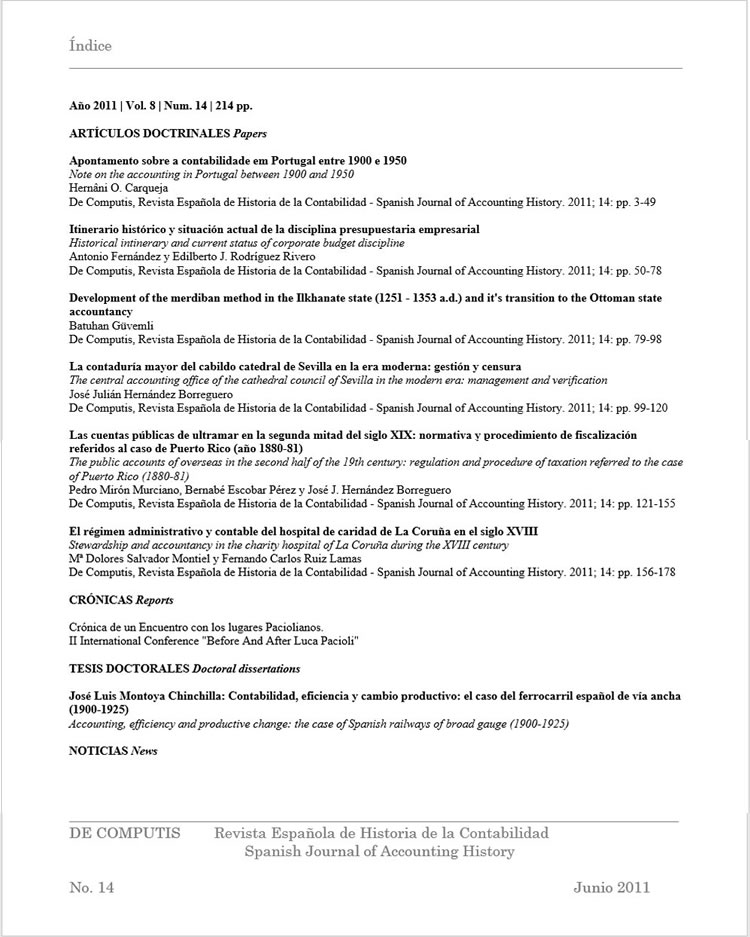Development of the Merdiban Method in the Ilkhanate State (1251 - 1353 a.d.) and it's transition to the Ottoman State accountancy
DOI:
https://doi.org/10.26784/issn.1886-1881.v8i14.108Palabras clave:
Ilkhanate State, Ottoman State, Accounting HistoryResumen
The study aims to observe the developments and improvements of the Merdiban method over time by benefiting from accounting records of the Ilkhanate State and the Ottoman State. Findings show that the political relations between the Ilkhanate State and the Ottoman State can be considered as the main factor for the spread of the Merdiban method in the Middle East. Some of the common features of these states that contributed to the emplacement of this method are mentioned in the study. From an accounting history perspective these common features are factors that helped in the development of the method.
Descargas
Citas
Darling. L.T. (2008): "Ottoman Accounting Prehistory". Proceedings of the 12th World Congress of Accounting Historians, Istanbul, July 20-24, Vol.III, p.2421-2433.
Elitaş C., Güvemli, O., Erkan, M., Aydemir O., Oğuz O. (2008): Accounting Method Used by Ottomans For 500 years : Stairs ( Merdiban) Method. 2008. Ankara. Turkey.
Göde, K. Eratnalılar 1327- 1381. (1994): Türk Tarih Kurumu Yayını VII. Dizi.p.153,33,148. Ankara.
Güzel, H. Celal. (1997): Genel Türk Tarihi (General Turkish History). Vol. 5. Istanbul.
Güvemli, O. (2007): Mali Tabloların Evrimi (Evolution of Financial Statements). Istanbul. Avcıol Publishings.
Güvemli, O. (2000): Tür k Devletleri Muhasebe Tarihi (Accounting History of Turkish States). Vol. 1, 2nd Edition. Istanbul.
Güvemli, B., Yılmaz, N., Çekici M. (2008): A Practical Application Of The Ladder Method: Muqata'ah Accounting. Proceedings of the 12th World Congress of Accounting Historians. Vol.II. Istanbul, Turkey. p. 1827-1853.
İbn-i Kemal Tarihi, Nuruosmaniye Kütüphanesi (Nuruosmaniye Library). Varak: 47.
Otar, İ. (1991): Muhasebede Siyakat Rakamları (Siyakat Script in Accountancy). Istanbul.
Öztüna Y. (1977): Başlangıcından Zamanımıza Kadar Büyük Türkiye Tarihi (Great Turkish History since its Begi nning). Vol. 2. Istanbul.
Togan, A. Z. Velidi. (1931): "Moğollar Devrinde Anadolu'nun İktisadi Vaziyeti", Türk Hukuk ve İktisat Tarihi Mecmuası. Year I. Ankara.
Sertoğlu, M. (1986): Osmanlı Tarih Lugatı (Ottoman History Glossary). Istanbul.
Solaş Ç., Otar İ. (1994): "Accounting System Practiced in the Near East During the Period 1220-1350 Based on the Book: The Risale-I Felekiyye". Accounting Historians Journal.
https://doi.org/10.2308/0148-4184.21.1.117
Uzunçarşılı, İ.H. (1975): Osmanlı Tarihi (Ottoman History). Vol.1. Istanbul.
Yıldız F., Güvemli, B., (2011): Camiu-l Hesab: A Merdiban Style Accounting Instruction Book From The Early 14th Century Ilkhanate State. Conference Proceedings of the 2nd Balkans and Middle East Countries Auditing and Accounting History Conference. Istanbul, Turkey Prime Ministry Ottoman Archives. MAD. 2760, Istanbul
Descargas
Publicado
Cómo citar
Número
Sección
Licencia

Esta obra está bajo una licencia internacional Creative Commons Atribución-NoComercial-CompartirIgual 4.0.






